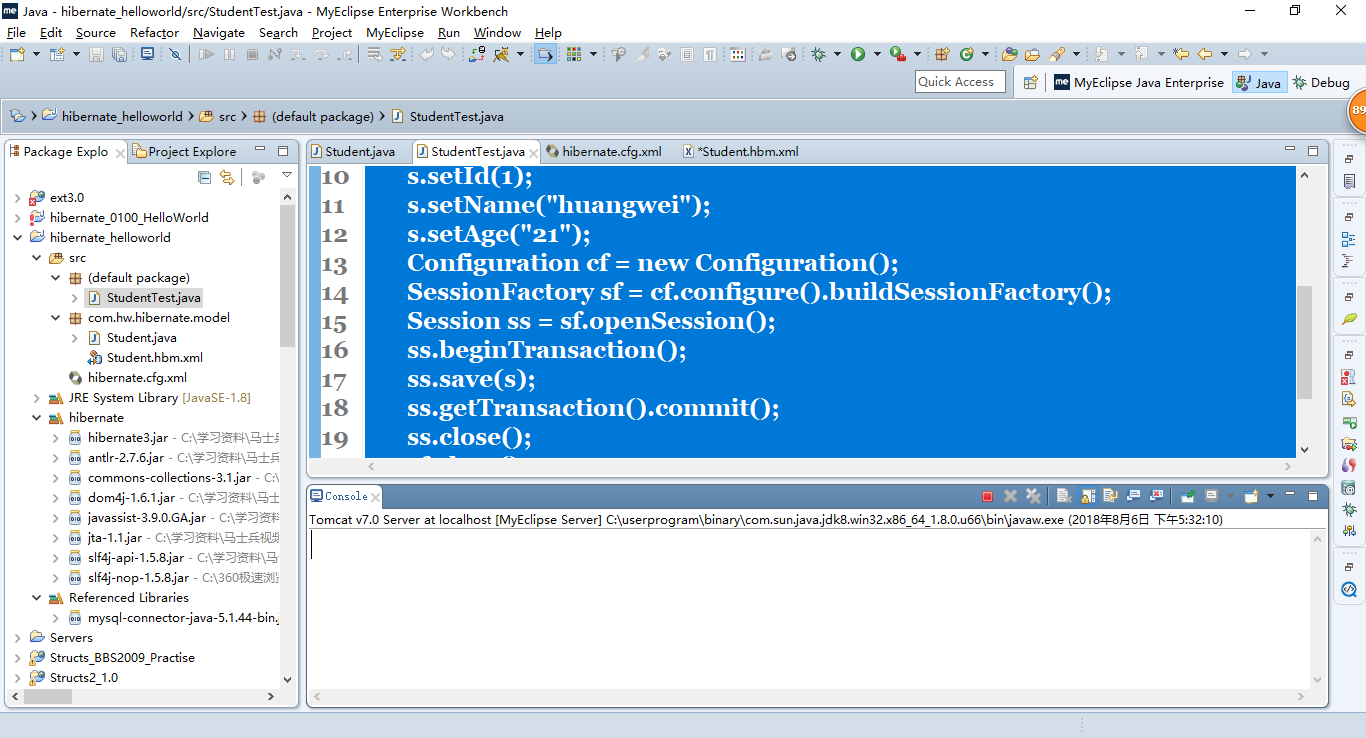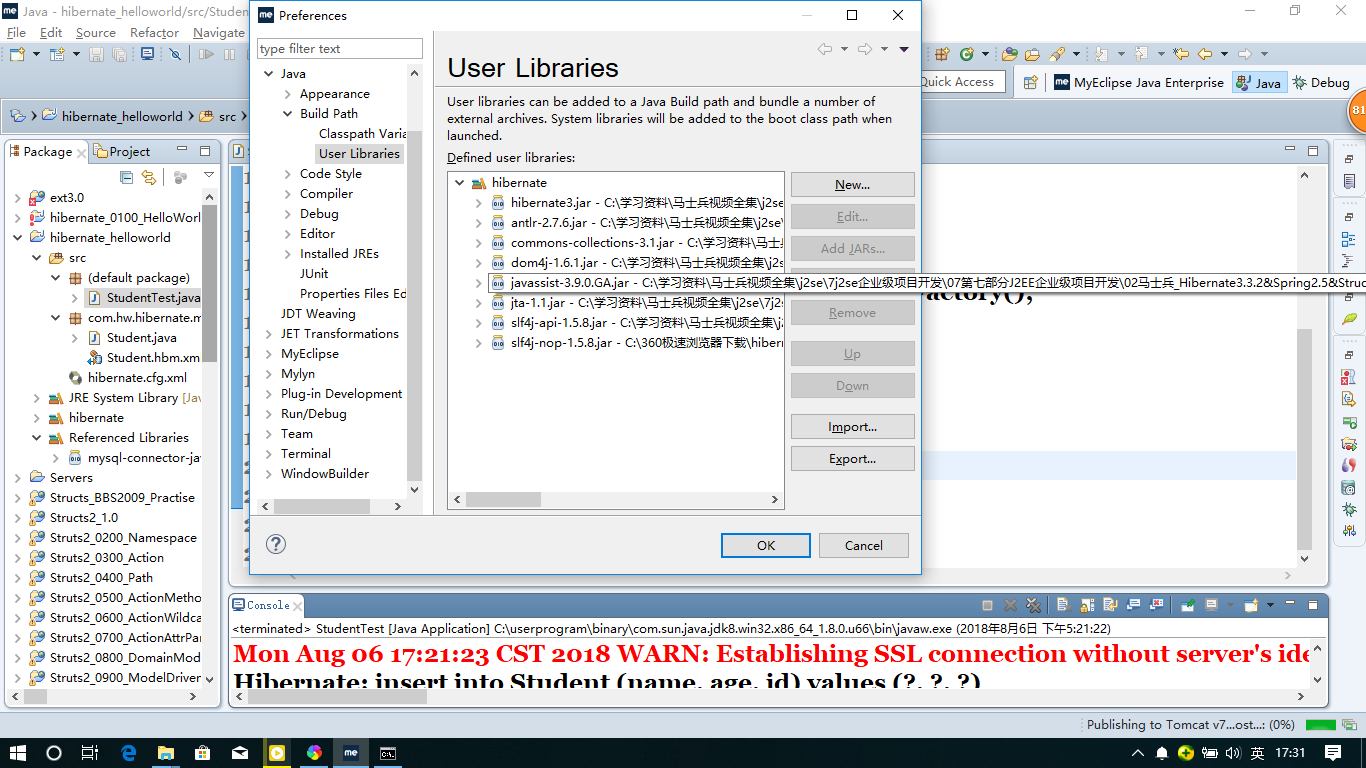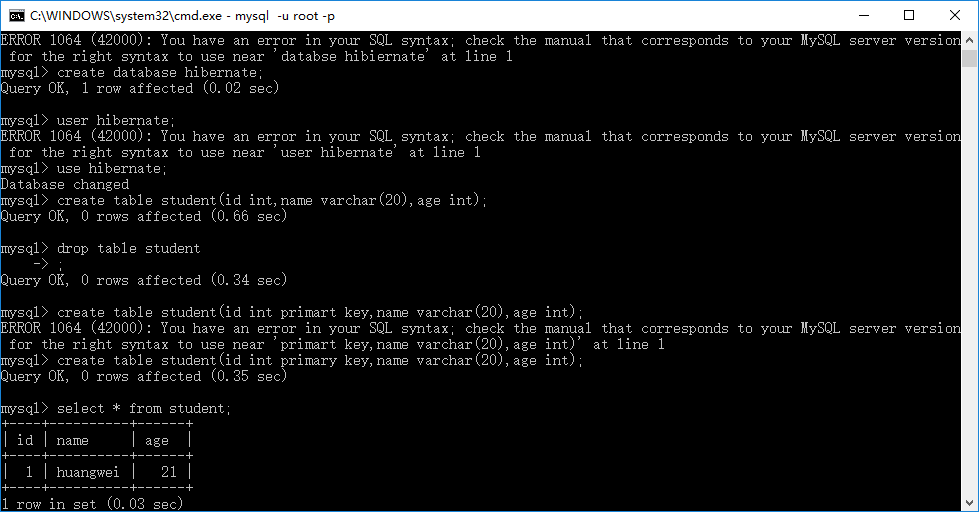
Hibernate是把以前的jdbc连接数据库的操作进行了一系列友好的封装,最好只用调用save即可,即将sql语句的这部分操作转化为面向对象的
Hibernate资源准备:
文档目录结构:

1.网址:http://hibernate.org/
2.所需资源
友情地址:https://pan.baidu.com/share/link?shareid=3410977257&uk=2971977658
3.下载好之后新建项目
选择windows - preference - user - Build path - User Libraries 建立自己的目录
选择 ADD EXTERNMAL JARS

然后到自己新建的heibernate项目 目录下 build path 选择user library 然后就引入了所需要的资源
4.建立modle以及数据库
Student.java
package com.hw.hibernate.model; public class Student { private int id; private String name; private String age; public int getId() { return id; } public void setId(int id) { this.id = id; } public String getName() { return name; } public void setName(String name) { this.name = name; } public String getAge() { return age; } public void setAge(String age) { this.age = age; } }
建立数据库
create database hibernate; use hibernate; create table student(id int primary key,name varchar(20),age int);
建立关系映射文件 hibernate.cfg.xml
从官方文档上copy改
<?xml version='1.0' encoding='utf-8'?> <!DOCTYPE hibernate-configuration PUBLIC "-//Hibernate/Hibernate Configuration DTD 3.0//EN" "http://hibernate.sourceforge.net/hibernate-configuration-3.0.dtd"> <hibernate-configuration> <session-factory> <!-- Database connection settings --> <property name="connection.driver_class">com.mysql.jdbc.Driver</property> <property name="connection.url">jdbc:mysql://localhost/hibernate</property> <property name="connection.username">root</property> <property name="connection.password"></property> <!-- JDBC connection pool (use the built-in) --> <property name="connection.pool_size">1</property> <!-- SQL dialect --> <property name="dialect">org.hibernate.dialect.MySQLDialect</property> <!-- Enable Hibernate's automatic session context management --> <property name="current_session_context_class">thread</property> <!-- Disable the second-level cache --> <property name="cache.provider_class">org.hibernate.cache.NoCacheProvider</property> <!-- Echo all executed SQL to stdout --> <property name="show_sql">true</property> <!-- Drop and re-create the database schema on startup --> <property name="hbm2ddl.auto">update</property> <mapping resource="com/hw/hibernate/model/Student.hbm.xml"/> <!-- <mapping class="com.bjsxt.hibernate.Teacher"/> --> </session-factory> </hibernate-configuration>
建立model元素和表的关系 Student.hbm.xml
<?xml version="1.0"?> <!DOCTYPE hibernate-mapping PUBLIC "-//Hibernate/Hibernate Mapping DTD 3.0//EN" "http://hibernate.sourceforge.net/hibernate-mapping-3.0.dtd"> <hibernate-mapping> <class name="com.hw.hibernate.model.Student"> <id name="id" /> <property name="name" /> <property name="age" /> </class> </hibernate-mapping>
建立测试 StudentTest.java
import org.hibernate.Session; import org.hibernate.SessionFactory; import org.hibernate.cfg.Configuration; import com.hw.hibernate.model.Student; public class StudentTest { public static void main(String args[]){ Student s = new Student(); s.setId(1); s.setName("huangwei"); s.setAge("21"); Configuration cf = new Configuration(); SessionFactory sf = cf.configure().buildSessionFactory(); Session ss = sf.openSession(); ss.beginTransaction(); ss.save(s); ss.getTransaction().commit(); ss.close(); sf.close(); } }
运行StudentTest.java 数据成功插入
